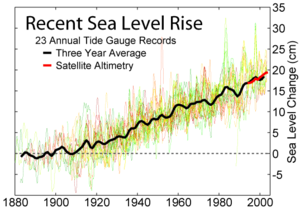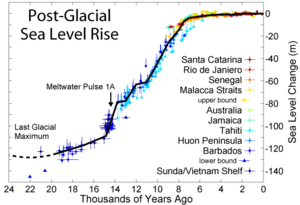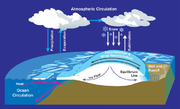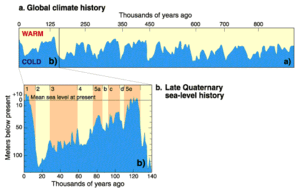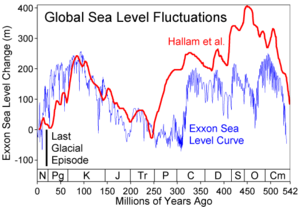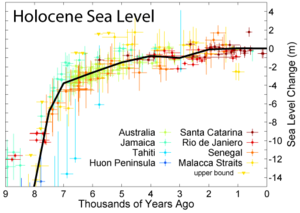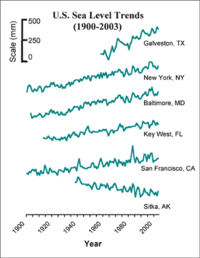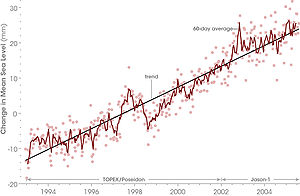
Current sea level rise
Did you know...
This selection is made for schools by a children's charity read more. SOS Children has looked after children in Africa for forty years. Can you help their work in Africa?
Sea-level rise is an increase in sea level. Multiple complex factors may influence this change.
Sea-level has risen about 130 meters (400 ft) since the peak of the last ice age about 18,000 years ago. Most of the rise occurred before 6,000 years ago. From 3,000 years ago to the start of the 19th century sea level was almost constant, rising at 0.1 to 0.2 mm/yr. Since 1900 the level has risen at 1 to 2 mm/yr; since 1993 satellite altimetry from TOPEX/Poseidon indicates a rate of rise of 3.1 ± 0.7 mm yr–1 . Church and White (2006) found a sea-level rise from January 1870 to December 2004 of 195 mm, a 20th century rate of sea-level rise of 1.7 ± 0.3 mm per yr and a significant acceleration of sea-level rise of 0.013 ± 0.006 mm per year. If this acceleration remains constant, then the 1990 to 2100 rise would range from 280 to 340 mm,. Sea-level rise can be a product of global warming through two main processes: thermal expansion of sea water and widespread melting of land ice. Global warming is predicted to cause significant rises in sea level over the course of the twenty-first century.
Overview of sea-level change
Local and eustatic sea level
Local mean sea level (LMSL) is defined as the height of the sea with respect to a land benchmark, averaged over a period of time (such as a month or a year) long enough that fluctuations caused by waves and tides are smoothed out. One must adjust perceived changes in LMSL to account for vertical movements of the land, which can be of the same order (mm/yr) as sea level changes. Some land movements occur because of isostatic adjustment of the mantle to the melting of ice sheets at the end of the last ice age. The weight of the ice sheet depresses the underlying land, and when the ice melts away the land slowly rebounds. Atmospheric pressure, ocean currents and local ocean temperature changes also can affect LMSL.
“ Eustatic” change (as opposed to local change) results in an alteration to the global sea levels, such as changes in the volume of water in the world oceans or changes in the volume of an ocean basin.
Short term and periodic changes
There are many factors which can produce short-term (a few minutes to 14 months) changes in sea level.
| Short-term (periodic) causes | Time scale (P = period) |
Vertical effect |
|---|---|---|
| Periodic sea level changes | ||
| Diurnal and semidiurnal astronomical tides | 12–24 h P | 0.2–10+ m |
| Long-period tides | ||
| Rotational variations ( Chandler wobble) | 14 month P | |
| Meteorological and oceanographic fluctuations | ||
| Atmospheric pressure | Hours to months | –0.7 to 1.3 m |
| Winds ( storm surges) | 1–5 days | Up to 5 m |
| Evaporation and precipitation (may also follow long-term pattern) | Days to weeks | |
| Ocean surface topography (changes in water density and currents) | Days to weeks | Up to 1 m |
| El Niño/southern oscillation | 6 mo every 5–10 yr | Up to 0.6 m |
| Seasonal variations | ||
| Seasonal water balance among oceans (Atlantic, Pacific, Indian) | ||
| Seasonal variations in slope of water surface | ||
| River runoff/floods | 2 months | 1 m |
| Seasonal water density changes (temperature and salinity) | 6 months | 0.2 m |
| Seiches | ||
| Seiches (standing waves) | Minutes to hours | Up to 2 m |
| Earthquakes | ||
| Tsunamis (generate catastrophic long-period waves) | Hours | Up to 10 m |
| Abrupt change in land level | Minutes | Up to 10 m |
Longer term changes
Various factors affect the volume or mass of the ocean, leading to long-term changes in eustatic sea level. The two primary influences are temperature (because the volume of water depends on temperature), and the mass of water locked up on land and sea as fresh water in rivers, lakes, glaciers, polar ice caps, and sea ice. Over much longer geological timescales, changes in the shape of the oceanic basins and in land/sea distribution will affect sea level.
Observational and modelling studies of mass loss from glaciers and ice caps indicate a contribution to sea-level rise of 0.2 to 0.4 mm/yr averaged over the 20th century.
Glaciers and ice caps
Each year about 8 mm (0.3 inch) of water from the entire surface of the oceans falls into the Antarctica and Greenland ice sheets as snowfall. If no ice returned to the oceans, sea level would drop 8 mm every year. Although approximately the same amount of water returns to the ocean in icebergs and from ice melting at the edges, scientists do not know which is greater — the ice going in or the ice coming out. The difference between the ice input and output is called the mass balance and is important because it causes changes in global sea level.
Ice shelves float on the surface of the sea and, if they melt, to first order they do not change sea level. Likewise, the melting of the northern polar ice cap which is composed of floating pack ice would not significantly contribute to rising sea levels. Because they are fresh, however, their melting would cause a very small increase in sea levels, so small that it is generally neglected. It can however be argued that if ice shelves melt it is a precursor to the melting of ice sheets on Greenland and Antarctica.
- Scientists lack knowledge of changes in terrestrial storage of water. Between 1910 and 1990, such changes may have contributed from –1.1 to +0.4 mm/yr.
- If small glaciers and polar ice caps on the margins of Greenland and the Antarctic Peninsula melt, the projected rise in sea level will be around 0.5 m. Melting of the Greenland ice sheet would produce 7.2 m of sea-level rise, and melting of the Antarctic ice sheet would produce 61.1 m of sea level rise. The collapse of the grounded interior reservoir of the West Antarctic Ice Sheet would raise sea level by 5-6 m.
- The snowline altitude is the altitude of the lowest elevation interval in which minimum annual snow cover exceeds 50%. This ranges from about 5,500 metres above sea-level at the equator down to sea level at about 70° N&S latitude, depending on regional temperature amelioration effects. Permafrost then appears at sea level and extends deeper below sea level polewards.
- As most of the Greenland and Antarctic ice sheets lie above the snowline and/or base of the permafrost zone, they cannot melt in a timeframe much less than several millennia; therefore it is likely that they will not, through melting, contribute significantly to sea level rise in the coming century. They can, however, do so through acceleration in flow and enhanced iceberg calving.
- Climate changes during the 20th century are estimated from modelling studies to have led to contributions of between –0.2 and 0.0 mm/yr from Antarctica (the results of increasing precipitation) and 0.0 to 0.1 mm/yr from Greenland (from changes in both precipitation and runoff).
- Estimates suggest that Greenland and Antarctica have contributed 0.0 to 0.5 mm/yr over the 20th century as a result of long-term adjustment to the end of the last ice age.
The current rise in sea level observed from tide gauges, of about 1.8 mm/yr, is within the estimate range from the combination of factors above but active research continues in this field. The uncertainty in the terrestrial storage term is particularly large.
Since 1992 the TOPEX/Poseidon and Jason 1 satellite programs have provided measurements of sea level change. Current data are available. The data show a mean sea level increase of 2.9±0.4 mm/yr. However, because significant short-term variability in sea level can occur, this recent increase does not necessarily indicate a long-term acceleration in sea level changes.
Geological influences
At times during Earth's long history, continental drift has arranged the land masses into very different configurations from those of today. When there were large amounts of continental crust near the poles, the rock record shows unusually low sea levels during ice ages, because there was lots of polar land mass upon which snow and ice could accumulate. During times when the land masses clustered around the equator, ice ages had much less effect on sea level. However, over most of geologic time, long-term sea level has been higher than today (see graph above). Only at the Permian-Triassic boundary ~250 million years ago was long-term sea level lower than today. Long term changes in sea level are the result of changes in the oceanic crust, with a downward trend expected to continue in the very long term.
During the glacial/interglacial cycles over the past few million years, sea level has varied by somewhat more than a hundred metres. This is primarily due to the growth and decay of ice sheets (mostly in the northern hemisphere) with water evaporated from the sea.
The Mediterranean Basin's gradual growth as the Neotethys basin, begun in the Jurassic, did not suddenly affect ocean levels. While the Mediterranean was forming during the past 100 million years, the average ocean level was generally 200 meters above current levels. However, the largest known example of marine flooding was when the Atlantic breached the Strait of Gibraltar at the end of the Messinian Salinity Crisis about 5.2 million years ago. This restored Mediterranean sea levels at the sudden end of the period when that basin had dried up, apparently due to geologic forces in the area of the Strait.
| Long-term causes | Range of effect | Vertical effect |
|---|---|---|
| Change in volume of ocean basins | ||
| Plate tectonics and seafloor spreading (plate divergence/convergence) and change in seafloor elevation (mid-ocean volcanism) | Eustatic | 0.01 mm/yr |
| Marine sedimentation | Eustatic | < 0.01 mm/yr |
| Change in mass of ocean water | ||
| Melting or accumulation of continental ice | Eustatic | 10 mm/yr |
| • Climate changes during the 20th century | ||
| •• Antarctica (the results of increasing precipitation) | Eustatic | -0.2 to 0.0 mm/yr |
| •• Greenland (from changes in both precipitation and runoff) | Eustatic | 0.0 to 0.1 mm/yr |
| • Long-term adjustment to the end of the last ice age | ||
| •• Greenland and Antarctica contribution over 20th century | Eustatic | 0.0 to 0.5 mm/yr |
| Release of water from earth's interior | Eustatic | |
| Release or accumulation of continental hydrologic reservoirs | Eustatic | |
| Uplift or subsidence of Earth's surface ( Isostasy) | ||
| Thermal-isostasy (temperature/density changes in earth's interior) | Local effect | |
| Glacio-isostasy (loading or unloading of ice) | Local effect | 10 mm/yr |
| Hydro-isostasy (loading or unloading of water) | Local effect | |
| Volcano-isostasy (magmatic extrusions) | Local effect | |
| Sediment-isostasy (deposition and erosion of sediments) | Local effect | < 4 mm/yr |
| Tectonic uplift/subsidence | ||
| Vertical and horizontal motions of crust (in response to fault motions) | Local effect | 1-3 mm/yr |
| Sediment compaction | ||
| Sediment compression into denser matrix (particularly significant in and near river deltas) | Local effect | |
| Loss of interstitial fluids (withdrawal of groundwater or oil) | Local effect | ≤ 55 mm/yr |
| Earthquake-induced vibration | Local effect | |
| Departure from geoid | ||
| Shifts in hydrosphere, aesthenosphere, core-mantle interface | Local effect | |
| Shifts in earth's rotation, axis of spin, and precession of equinox | Eustatic | |
| External gravitational changes | Eustatic | |
| Evaporation and precipitation (if due to a long-term pattern) | Local effect | |
Past changes in sea level
The sedimentary record
For generations, geologists have been trying to explain the obvious cyclicity of sedimentary deposits observed everywhere we look. The prevailing theories hold that this cyclicity primarily represents the response of depositional processes to the rise and fall of sea level. In the rock record, geologists see times when sea level was astoundingly low alternating with times when sea level was much higher than today, and these anomalies often appear worldwide. For instance, during the depths of the last ice age 18,000 years ago when hundreds of thousands of cubic miles of ice were stacked up on the continents as glaciers, sea level was 120 m (390 ft) lower, locations that today support coral reefs were left high and dry, and coastlines were miles farther basinward from the present-day coastline. It was during this time of very low sea level that there was a dry land connection between Asia and Alaska over which humans are believed to have migrated to North America (see Bering Land Bridge).
However, for the past 6,000 years (a few centuries before the first known written records), the world's sea level has been gradually approaching the level we see today. During the previous interglacial about 120,000 years ago, sea level was for a short time about 6 m higher than today, as evidenced by wave-cut notches along cliffs in the Bahamas. There are also Pleistocene coral reefs left stranded about 3 meters above today's sea level along the southwestern coastline of West Caicos Island in the West Indies. These once-submerged reefs and nearby paleo-beach deposits are silent testimony that sea level spent enough time at that higher level to allow the reefs to grow (exactly where this extra sea water came from—Antarctica or Greenland—has not yet been determined). Similar evidence of geologically recent sea level positions is abundant around the world.
Estimates
See IPCC TAR, figure 11.4 for a graph of sea level changes over the past 140,000 years.
- Sea-level rise estimates from satellite altimetry since 1992 (about 2.8 mm/yr) exceed those from tide gauges. It is unclear whether this represents an increase over the last decades, variability, or problems with satellite calibration.
- Church and White (2006) report an acceleration of SLR since 1870. This is a revision since 2001, when the TAR stated that measurements have detected no significant acceleration in the recent rate of sea level rise.
- Based on tide gauge data, the rate of global average sea level rise during the 20th century lies in the range 0.8 to 3.3 mm/yr, with an average rate of 1.8 mm/yr.
- Recent studies of Roman wells in Caesarea and of Roman piscinae in Italy indicate that sea level stayed fairly constant from a few hundred years AD to a few hundred years ago.
- Based on geological data, global average sea level may have risen at an average rate of about 0.5 mm/yr over the last 6,000 years and at an average rate of 0.1 to 0.2 mm/yr over the last 3,000 years.
- Since the Last Glacial Maximum about 20,000 years ago, sea level has risen by over 120 m (averaging 6 mm/yr) as a result of melting of major ice sheets. A rapid rise took place between 15,000 and 6,000 years ago at an average rate of 10 mm/yr which accounted for 90 m of the rise; thus in the period since 20,000 years BP (excluding the rapid rise from 15-6 kyr BP) the average rate was 3 mm/yr.
- A significant event was Meltwater Pulse 1A (mwp-1A), when sea level rose approximately 20 m over a 500 year period about 14,200 years ago. This is a rate of about 40 mm/yr. Recent studies suggest the primary source was meltwater from the Antarctic, perhaps causing the south-to-north cold pulse marked by the Southern Hemisphere Huelmo/Mascardi Cold Reversal, which preceded the Northern Hemisphere Younger Dryas
- Relative sea level rise at specific locations is often 1-2 mm/yr greater or less than the global average. Along the US mid-Atlantic and Gulf Coasts, for example, sea level is rising approximately 3 mm/yr
U. S. Tide Gauge Measurements
Tide gauges in the United States show considerable variation because some land areas are rising and some are sinking. For example, over the past 100 years, the rate of sea level rise varies from about an increase of 0.36 inches (9.1 mm) per year along the Louisiana Coast (due to land sinking), to a drop of a few inches per decade in parts of Alaska. The rate of sea level rise increased during the 1993-2003 period compared with the longer-term average (1961-2003), although it is unclear whether the faster rate reflects a short-term variation or an increase in the long-term trend.
Amsterdam Sea Level Measurements
The longest running sea-level measurements are recorded at Amsterdam, in the Netherlands - most of which lies beneath sea level, hence the name. Records from 1700 onwards can be found at http://www.pol.ac.uk/psmsl/longrecords/longrecords.html. Since 1850, a rise of approx 1.5mm/year is shown here.
Australian Sea Level Change
The London Royal Society calculates net sea level rise in Australia at 1mm/yr - an important result for the Southern Hemisphere. The National Tidal Centre also graphs 32 gauges, some since 1880, for the entire coastline
Future sea level rise
In 2001, the Intergovernmental Panel on Climate Change's Third Assessment Report predicted that by 2100, global warming will lead to a sea level rise of 9 to 88 cm. At that time no significant acceleration in the rate of sea level rise during the 20th century had been detected. Subsequently, Church and White found acceleration of 0.013 ± 0.006 mm/yr².
These sea level rises could lead to difficulties for shore-based communities in the next centuries: for example, many major cities such as London and New Orleans already need storm-surge defenses, and would need more if sea level rose, though they also face issues such as sinking land.
Future sea level rise, like the recent rise, is not expected to be globally uniform (details below). Some regions show a sea-level rise substantially more than the global average (in many cases of more than twice the average), and others a sea level fall. However, models disagree as to the likely pattern of sea level change.
Intergovernmental Panel on Climate Change results
The results from the IPCC Third Assessment Report (TAR) sea level chapter (convening authors John A. Church and Jonathan M. Gregory) are given below.
| IPCC change factors 1990-2100 | IS92a prediction | SRES prediction |
|---|---|---|
| Thermal expansion | 110 to 430 mm | |
| Glaciers | 10 to 230 mm (or 50 to 110 mm) |
|
| Greenland ice | –20 to 90 mm | |
| Antarctic ice | –170 to 20 mm | |
| Terrestrial storage | –83 to 30 mm | |
| Ongoing contributions from ice sheets in response to past climate change | 0 to 55 mm | |
| Thawing of permafrost | 0 to 5 mm | |
| Deposition of sediment | not specified | |
| Total global-average sea level rise (IPCC result, not sum of above) |
110 to 770 mm | 90 to 880 mm (central value of 480 mm) |
The sum of these components indicates a rate of eustatic sea level rise (corresponding to a change in ocean volume) from 1910 to 1990 ranging from –0.8 to 2.2 mm/yr, with a central value of 0.7 mm/yr. The upper bound is close to the observational upper bound (2.0 mm/yr), but the central value is less than the observational lower bound (1.0 mm/yr), i.e., the sum of components is biased low compared to the observational estimates. The sum of components indicates an acceleration of only 0.2 (mm/yr)/century, with a range from –1.1 to +0.7 (mm/yr)/century, consistent with observational finding of no acceleration in sea level rise during the 20th century. The estimated rate of sea-level rise from anthropogenic climate change from 1910 to 1990 (from modeling studies of thermal expansion, glaciers and ice sheets) ranges from 0.3 to 0.8 mm/yr. It is very likely that 20th century warming has contributed significantly to the observed sea-level rise, through thermal expansion of sea water and widespread loss of land ice.
A common perception is that the rate of sea-level rise should have accelerated during the latter half of the 20th century, but tide gauge data for the 20th century show no significant acceleration. Estimates obtained are based on AOGCMs for the terms directly related to anthropogenic climate change in the 20th century, i.e., thermal expansion, ice sheets, glaciers and ice caps... The total computed rise indicates an acceleration of only 0.2 (mm/yr)/century, with a range from -1.1 to +0.7 (mm/yr)/century, consistent with observational finding of no acceleration in sea-level rise during the 20th century. The sum of terms not related to recent climate change is -1.1 to +0.9 mm/yr (i.e., excluding thermal expansion, glaciers and ice caps, and changes in the ice sheets due to 20th century climate change). This range is less than the observational lower bound of sea level rise. Hence it is very likely that these terms alone are an insufficient explanation, implying that 20th century climate change has made a contribution to 20th century sea level rise.
Uncertainties and criticisms regarding IPCC results
- Tide records with a rate of 180 mm/century going back to the 19th century show no measurable acceleration throughout the late 19th and first half of the 20th century. The IPCC attributes about 60 mm/century to melting and other eustatic processes, leaving a residual of 120 mm of 20th century rise to be accounted for. Global ocean temperatures by Levitus et al are in accord with coupled ocean/atmosphere modelling of greenhouse warming, with heat-related change of 30 mm. Melting of polar ice sheets at the upper limit of the IPCC estimates could close the gap, but severe limits are imposed by the observed perturbations in Earth rotation. (Munk 2002)
- By the time of the IPCC TAR, attribution of sea-level changes had a large unexplained gap between direct and indirect estimates of global sea-level rise. Most direct estimates from tide gauges give 1.5–2.0 mm/yr, whereas indirect estimates based on the two processes responsible for global sea-level rise, namely mass and volume change, are significantly below this range. Estimates of the volume increase due to ocean warming give a rate of about 0.5 mm/yr and the rate due to mass increase, primarily from the melting of continental ice, is thought to be even smaller. One study confirmed tide gauge data is correct, and concluded there must be a continental source of 1.4 mm/yr of fresh water. (Miller 2004)
- From (Douglas 2002): "In the last dozen years, published values of 20th century GSL rise have ranged from 1.0 to 2.4 mm/yr. In its Third Assessment Report, the IPCC discusses this lack of consensus at length and is careful not to present a best estimate of 20th century GSL rise. By design, the panel presents a snapshot of published analysis over the previous decade or so and interprets the broad range of estimates as reflecting the uncertainty of our knowledge of GSL rise. We disagree with the IPCC interpretation. In our view, values much below 2 mm/yr are inconsistent with regional observations of sea-level rise and with the continuing physical response of Earth to the most recent episode of deglaciation."
- The strong 1997-1998 El Niño caused regional and global sea level variations, including a temporary global increase of perhaps 20 mm. The IPCC TAR's examination of satellite trends says the major 1997/98 El Niño-Southern Oscillation (ENSO) event could bias the above estimates of sea-level rise and also indicate the difficulty of separating long-term trends from climatic variability.
Glacier contribution
It is well known that glaciers are subject to surges in their rate of movement with consequent melting when they reach lower altitudes and/or the sea. The contributors to Annals of Glaciology , Volume 36 (2003) discussed this phenomenon extensively and it appears that slow advance and rapid retreat have persisted throughout the mid to late Holocene in nearly all of Alaska's glaciers. Historical reports of surge occurrences in Iceland's glaciers go back several centuries. Thus rapid retreat can have several other causes than CO2 increase in the atmosphere.
The results from Dyurgerov show a sharp increase in the contribution of mountain and subpolar glaciers to sea level rise since 1996 (0.5 mm/yr) to 1998 (2 mm/yr) with an average of approx. 0.35 mm/yr since 1960.
Of interest also is Arendt et al, who estimate the contribution of Alaskan glaciers of 0.14±0.04 mm/yr between the mid 1950s to the mid 1990s increasing to 0.27 mm/yr in the middle and late 1990s.
Greenland contribution
Krabill et al. estimate a net contribution from Greenland to be at least 0.13 mm/yr in the 1990s. Joughin et al. have measured a doubling of the speed of Jakobshavn Isbræ between 1997 and 2003. This is Greenland's largest-outlet glacier; it drains 6.5% of the ice sheet, and is thought to be responsible for increasing the rate of sea level rise by about 0.06 millimeters per year, or roughly 4% of the 20th century rate of sea level increase. In 2004, Rignot et al. estimated a contribution of 0.04±0.01 mm/yr to sea level rise from southeast Greenland.
Rignot and Kanagaratnam produced a comprehensive study and map of the outlet glaciers and basins of Greenland. They found widespread glacial acceleration below 66 N in 1996 which spread to 70 N by 2005; and that the ice sheet loss rate in that decade increased from 90 to 200 cubic km/yr; this corresponds to an extra 0.25 to 0.55 mm/yr of sea level rise.
In July 2005 it was reported that the Kangerdlugssuaq glacier, on Greenland's east coast, was moving towards the sea three times faster than a decade earlier. Kangerdlugssuaq is around 1000 m thick, 7.2 km (4.5 miles) wide, and drains about 4% of the ice from the Greenland ice sheet. Measurements of Kangerdlugssuaq in 1988 and 1996 showed it moving at between 5 and 6 km/yr (3.1 to 3.7 miles/yr) (in 2005 it was moving at 14 km/yr (8.7 miles/yr).
According to the 2004 Arctic Climate Impact Assessment, climate models project that local warming in Greenland will exceed 3° Celsius during this century. Also, ice sheet models project that such a warming would initiate the long-term melting of the ice sheet, leading to a complete melting of the Greenland ice sheet over several millennia, resulting in a global sea level rise of about seven meters.
Effects of snowline and permafrost
The snowline altitude is the altitude of the lowest elevation interval in which minimum annual snow cover exceeds 50%. This ranges from about 5500 metres above sea-level at the equator down to sea-level at about 65° N&S latitude, depending on regional temperature amelioration effects. Permafrost then appears at sea-level and extends deeper below sea-level pole-wards. The depth of permafrost and the height of the ice-fields in both Greenland and Antarctica means that they are largely invulnerable to rapid melting. Greenland Summit is at 3200 metres, where the average annual temperature is minus 32 °C. So even a projected 4 °C rise in temperature leaves it well below the melting point of ice. Frozen Ground 28, December 2004, has a very significant map of permafrost affected areas in the Arctic. The continuous permafrost zone includes all of Greenland, the North of Labrador, NW Territories, Alaska north of Fairbanks, and most of NE Siberia north of Mongolia and Kamchatka. Continental ice above permafrost is very unlikely to melt quickly. As most of the Greenland and Antarctic ice sheets lie above the snowline and/or base of the permafrost zone, they cannot melt in a timeframe much less than several millennia; therefore they are unlikely to contribute significantly to sea-level rise in the coming century.
Polar ice
The sea level will rise above its current level if more polar ice melts. However, compared to the heights of the ice ages, today there are very few continental ice sheets remaining to be melted. It is estimated that Antarctica, if fully melted, would contribute more than 60 metres of sea level rise, and Greenland would contribute more than 7 metres. Small glaciers and ice caps on the margins of Greenland and the Antarctic Peninsula might contribute about 0.5 metres. While the latter figure is much smaller than for Antarctica or Greenland it could occur relatively quickly (within the coming century) whereas melting of Greenland would be slow (perhaps 1500 years to fully deglaciate at the fastest likely rate) and Antarctica even slower. However, this calculation does not account for the possibility that as meltwater flows under and lubricates the larger ice sheets, they could begin to move much more rapidly towards the sea.
In 2002, Rignot and Thomas found that the West Antarctic and Greenland ice sheets were losing mass, while the East Antarctic ice sheet was probably in balance (although they could not determine the sign of the mass balance for The East Antarctic ice sheet). Kwok and Comiso (J. Climate, v15, 487-501, 2002) also discovered that temperature and pressure anomalies around West Antarctica and on the other side of the Antarctic Peninsula correlate with recent Southern Oscillation events.
In 2004 Rignot et al. estimated a contribution of 0.04±0.01 mm/yr to sea level rise from South East Greenland. In the same year, Thomas et al. found evidence of an accelerated contribution to sea level rise from West Antarctica. The data showed that the Amundsen Sea sector of the West Antarctic Ice Sheet was discharging 250 cubic kilometres of ice every year, which was 60% more than precipitation accumulation in the catchment areas. This alone was sufficient to raise sea level at 0.24 mm/yr. Further, thinning rates for the glaciers studied in 2002-2003 had increased over the values measured in the early 1990s. The bedrock underlying the glaciers was found to be hundreds of meters deeper than previously known, indicating exit routes for ice from further inland in the Byrd Subpolar Basin. Thus the West Antarctic ice sheet may not be as stable as has been supposed.
In 2005 it was reported that during 1992-2003, East Antarctica thickened at an average rate of about 18 mm/yr while West Antarctica showed an overall thinning of 9 mm/yr. associated with increased precipitation. A gain of this magnitude is enough to slow sea-level rise by 0.12±0.02 mm/yr.
Effects of sea level rise
Based on the projected increases stated above, the IPCC TAR WG II report notes that current and future climate change would be expected to have a number of impacts, particularly on coastal systems. Such impacts may include increased coastal erosion, higher storm-surge flooding, inhibition of primary production processes, more extensive coastal inundation, changes in surface water quality and groundwater characteristics, increased loss of property and coastal habitats, increased flood risk and potential loss of life, loss of nonmonetary cultural resources and values, impacts on agriculture and aquaculture through decline in soil and water quality, and loss of tourism, recreation, and transportation functions.
There is an implication that many of these impacts will be detrimental. The report does, however, note that owing to the great diversity of coastal environments; regional and local differences in projected relative sea level and climate changes; and differences in the resilience and adaptive capacity of ecosystems, sectors, and countries, the impacts will be highly variable in time and space and will not necessarily be negative in all situations.
Statistical data on the human impact of sea level rise is scarce. A study in the April, 2007 issue of Environment and Urbanization reports that 634 million people live in coastal areas within 30 feet (9.1 m) of sea level. The study also reported that about two thirds of the world's cities with over five million people are located in these low-lying coastal areas.
Are islands "drowning"?
IPCC assessments suggest that deltas and small island states are particularly vulnerable to sea level rise caused by both thermal expansion and ocean volume. Relative sea level rise (mostly caused by subsidence) is currently causing substantial loss of lands in some deltas. Sea level changes have not yet been conclusively proven to have directly resulted in environmental, humanitarian, or economic losses to small island states, but the IPCC and other bodies have found this a serious risk scenario in coming decades.
Many media reports have focused the island nations of the Pacific, notably the Polynesian island of Tuvalu, which based on more severe flooding events in recent years, was thought to be "sinking" due to sea level rise. A scientific review in 2000 reported that based on University of Hawaii gauge data, Tuvalu had experienced a negligible increase in sea-level of 0.07 mm a year over the past two decades, and that ENSO had been a larger factor in Tuvalu's higher tides in recent years. A subsequent study by John Hunter from the University of Tasmania, however, adjusted for ENSO effects and the movement of the gauge (which was thought to be sinking). Hunter concluded that Tuvalu had been experiencing sea-level rise of about 1.2 mm per year. The recent more frequent flooding in Tuvalu may also be due to an erosional loss of land during and following the actions of 1997 cyclones Gavin, Hina, and Keli.
Reuters has reported other Pacific islands are facing a severe risk including Tegua island in Vanuatu. Claims that Vanuatu data shows no net sea level rise, are not substantiated by tide gauge data. Vanuatu tide gauge data show a net rise of ~50 mm from 1994-2004. Linear regression of this short time series suggests a rate of rise of ~7 mm/y, though there is considerable variability and the exact threat to the islands is difficult to assess using such a short time series.
Numerous options have been proposed that would assist island nations to adapt to rising sea level.
Satellite sea level measurement
Sea level rise estimates from satellite altimetry are 3.1 +/- 0.4 mm/yr for 1993-2003 (Leuliette et al. (2004)). This exceeds those from tide gauges. It is unclear whether this represents an increase over the last decades; variability; true differences between satellites and tide gauges; or problems with satellite calibration.
Since 1992 the NASA/CNES TOPEX/Poseidon (T/P) and Jason-1 satellite programs have provided measurements of sea level change. The current data are available at http://sealevel.colorado.edu/ and http://sealevel.jpl.nasa.gov/. The data show a mean sea level increase of 2.8±0.4 mm/yr. This includes an apparent increase to 3.7±0.2 mm/yr during the period 1999 through 2004. Satellites ERS-1 ( July 17 1991- March 10 2000), ERS-2 ( April 21 1995-), and Envisat ( March 1 2002-) also have sea surface altimeter components but are of limited use for measuring global mean sea level due to less detailed coverage.
- TOPEX/Poseidon began its series of global measurements of sea surface height in 1992, and the scientific mission was ended in October 2005.
- Jason-1, launched December 7, 2001, has now taken over the mission and is flying the same groundtrack.
- Ocean Surface Topography Mission/Jason-2 was launched on June 20, 2008, and after calibration and validation will replace Jason-1 in the same orbit.
Because significant short-term variability in sea level can occur, extracting the global mean sea level information is complex. Also, the satellite data has a much shorter record than tidal gauges, which have been found to require years of operation to extract trends.
There is a range of distances involved.
- 140 to 320 mm: Increased height of sea level within 1997-1998 El Niño Pacific region.
- 140 mm: Range of typical regional sea level variations (±70 mm).
- 100 mm: Accuracy of ERS-1 radar altimeter.
- 43 mm: Accuracy of ocean surface height calculations with T/P.
- 30 to 40 mm: Accuracy of TOPEX and POSEIDON-1 radar altimeters, which measure distance to ocean surface.
- 20 to 30 mm: Accuracy of determination of T/P satellite orbital height (laser ranging, doppler shifts, GPS).
- 20 mm: Accuracy of Jason-1 POSEIDON-2 radar altimeter.
- 7-14 mm: Global mean sea level surge during 1997-1998 El Niño period.
- Several mm: Precision of global mean sea level measurement after averaging 10-day coverage.
- 10 mm: Stability of T/P orbit heights over 4 years.
- 2.8 ±0.4 mm: Average annual global sea level rise since 1992 according to T/P.
There apparently is a problem with the ERS-2 altimeter. Mean sea level changes were compared between satellites for 60°N and 60°S from May 1995 to June 1996:
- -4.7 ±1.5 mm/yr for ERS-1
- -5.6 ±1.3 mm/yr for TOPEX
- +9.0 ±2.1 mm/yr for ERS-2
Ongoing altimeter comparisons are available at: http://www7300.nrlssc.navy.mil/altimetry/intercomp.html
The various readings there are of current sea level variations, not global sea level, so the comparison is only in differences between the values. That data is of variations in centimeters; further processing is done to reach the millimeter-level resolution needed for mean sea level studies.
Comparisons of T/P with Pacific island tide gauge data show that the monthly mean deviations are accurate at the level of 20 mm.
Also, it should be noted that since satellite results are partially calibrated against tide gauge readings, they are not an entirely independent source.
The strong 1997-1998 El Niño event "has imprinted a strong signature on the sea surface height field in the mid-latitude eastern Pacific. This signal will be tracked over the next decade as the eastern boundary manifestation of this El Niño event propagates westward toward the Kuroshio Extension."
Other satellites:
- Geosat Follow-On is a U.S. Navy altimeter mission that was launched on February 10, 1998. On November 29, 2000, the Navy accepted the satellite as operational. During its mission life, the satellite will be retained in the GEOSAT Exact Repeat Mission (ERM) orbit (800 km altitude, 108 deg inclination, 0.001 eccentricity, and, 100 min period). This 17-day Exact Repeat Orbit (ERO) retraces the ERM ground track to +/-1 km. As with the original GEOSAT ERM, the data will be available for ocean science through NOAA/NOS and NOAA/NESDIS. Radar Altimeter - single frequency (13.5 GHz) with 35 mm height precision. Note that the GPS receiver is not functional.
- Geosat Follow-On @ NOAA/LSA
- NAVY GEOSAT FOLLOW-ON (GFO) ALTIMETRY MISSION
- NASA WFF Geosat Follow-On
Other sea level analysis:
- Sea Level Analysis from ERS Altimetry
- Ssalto/Duacs multimission altimeter products: Combined current data from Topex/Poseidon, Geosat Follow On, Jason-1 and Envisat.

